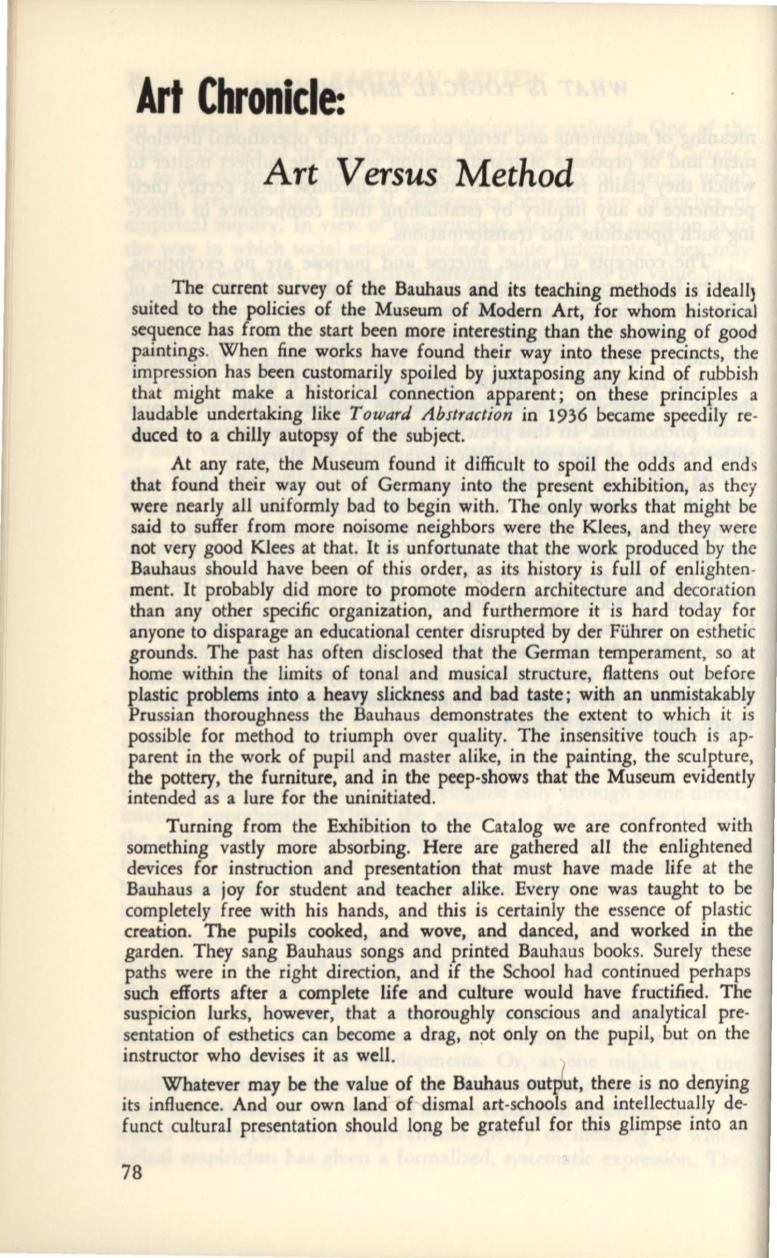
Art Chronicle:
Art Versus Method
The current survey of the Bauhaus and its teaching methods is ideall)
suited to the policies of the Museum of Modern Art, for whom historical
sequence has from the start been more interesting than the showing of good
paintings. When fine works have found their way into these precincts, the
impression has been customarily spoiled by juxtaposing any kind of rubbish
that might make a historical connection apparent; on these principles a
laudable undertaking like
Toward Abstraction
in 1936 became speedily re–
duced to a chilly autopsy of the subject.
At any rate, the Museum found it difficult to spoil the odds and ends
that found their way out of Germany into the present exhibition, as they
were nearly all uniformly bad to begin with. The only works that might be
said to suffer from more noisome neighbors were the Klees, and they were
not very good Klees at that. It is unfortunate that the work produced by the
Bauhaus should have been of this order, as its history is full of enlighten–
ment. It probably did more to promote modern architecture and decoration
than any other specific organization, and furthermore it is hard today for
anyone to disparage an educational center disrupted by der Fiihrer on esthetic
grounds. The past has often disclosed that the German temperament, so at
home within the limits of tonal and musical structure, flattens out before
plastic problems into a heavy slickness and bad taste; with an unmistakably
Prussian thoroughness the Bauhaus demonstrates the extent to which it is
possible for method to triumph over quality. The insensitive touch is ap–
parent in the work of pupil and master alike, in the painting, the sculpture,
the pottery, the furniture, and in the peep-shows that the Museum evidently
intended as a lure for the uninitiated.
Turning from the Exhibition to the Catalog we are confronted with
something vastly more absorbing. Here are gathered all the enlightened
devices for instruction and presentation that must have made life at the
Bauhaus a joy for student and teacher alike. Every one was taught to be
completely free with his hands, and this is certainly the essence of plastic
creation. The pupils cooked, and wove, and danced, and worked in the
garden. They sang Bauhaus songs and printed Bauhaus books. Surely these
paths were in the right direction, and if the School had continued perhaps
such efforts after a complete life and culture would have fructified. The
suspicion lurks, however, that a thoroughly conscious and analytical pre–
sentation of esthetics can become a drag,
n~t
only on the pupil, but on the
instructor who devises it as well.
(
Whatever may be the value of the Bauhaus output, there is no denying
its influence. And our own land' of dismal art-schools and intellectually de–
funct cultural presentation should long be grateful for this glimpse into an
78


